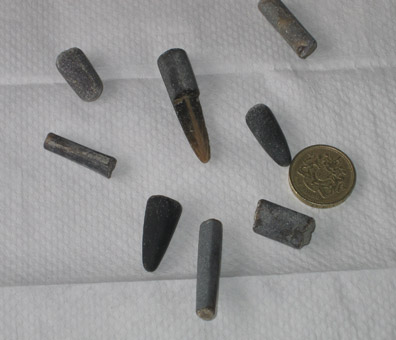The Joy of Belemnites – An Easy Fossil to Find
Belemnites extinct members of the cephalopod class and consequently close relatives of extant animals such as squids and cuttlefish are often a young person’s introduction to the joys of fossil hunting.
Belemnites
Complete belemnite fossils are exceptionally rare, although several Jurassic-aged fossil specimens are known from southern England. However, the part of the animal that is usually preserved as a fossil is a solid piece of calcite called the guard. The guard was an element of the internal skeleton positioned towards the rear of the creature. These distinctive bullet shaped fossils with a pointed end are easy to find in certain Jurassic marine sediments. They often occur in great numbers, perhaps indicating how numerous these marine invertebrates were or how well preserved the guards are. Indeed at Lyme Regis for example, some of the strata between the Cobb at Lyme and Charmouth are named after the number of belemnite fossils found therein.
Fossil Belemnites from Lyme Regis

Picture credit: Everything Dinosaur
The picture above shows a selection of belemnite fossils found by members of the Everything Dinosaur team on the beach between Charmouth and Lyme Regis. The pound coin in the photograph provides scale. The word belemnite comes from the Greek for “dart” and looking at the picture above it is easy to see the reason for this name. Finding belemnite guards is relatively easy, they do stand out against the small, round pebbles and stones found on the foreshore and collecting them can be fun. Everything Dinosaur team members have picked up over a dozen or so in just a few minutes of searching a small area.
We supply a model of a belemnite. This is a useful item as it allows us to illustrate where on the animal the guard would be located and helps to “bring to life” the fossils that young dinosaur fans have found.
To see the model of a belemnite, prehistoric animal figures and dinosaur models: Dinosaur and Prehistoric Animal Models.
The Model Belemnite available from Everything Dinosaur
Picture credit: Everything Dinosaur







I just found three in a creek here in NE Mississippi. The creek also has a bunch of Big Shells so my question. Is it rare to find them here in NE Mississippi
Both belemnites and ammonite fossils are known from Mississippi, these finds are not exceptionally rare.
It isnt rare to find the bullet shaped bit of the belemnite. Whole fossils are rare!
I just found one in Skegness, Lincolnshire….a bit far from the south coast or would they have been in this area as well?
Is there anything I can do to clean it and make it shiny?
Such fossils can be transported quite far by the action of the tides, as for cleaning, these fossils are very robust, just give it a good wash. Hope this helps.
Just found one on the eatstern end of the mendip hills in somerset, UK. Lots of ammonites around too.
We wish you every success with your fossil hunting activities.
Hi, are belemnites the cylindrical fossil often found in gravel? We’ve found loads of them but never one with a pointed end.
Gravels are deposits of rocks that have been transported by water and they contain a wide variety of different types of heavily eroded materials, what they consist of is dependent on the rocks in the region where the water travels. Many gravels used in the commercial trade were deposited by rivers during the Pleistocene Epoch but they can contain much older pieces of sedimentary rock. The calcite guard of Belemnites are quite resistant to erosion and fragments of guards often colour brown, blue/grey or with a purple tint are relatively commmon. To determine whether you have a Belmenite guard or just a piece of rolled inert rock, look carefully at the end of the object. If you can see fine lines radiating outwards from the centre then this is a sure sign that you have a belemnite guard on your drive way.
Found one today in my garden just yards from the Norfolk shore.
Our congratulations to you, good luck with your fossil collecting.
I have found hundreds of Balemnite fossils and fragments in south eastern South Dakota. Does that mean anything?
South western I meant
Belemnite fossils generally consist of a dart shaped, solid piece of calcite called the guard. These fossils are found in Jurassic and Cretaceous marine sediments and can be found in huge numbers, so much so that the strata is often referred to as Belemnite Beds. They are extremely common and such deposits can help palaeontologists date the rocks the fossils were found in. If you want more information about the fossils you have found, we suggest you go to your local library and enquire about any local geology groups that can be contacted. They will, I’m sure be happy to provide you more information about the South Dakota locality.